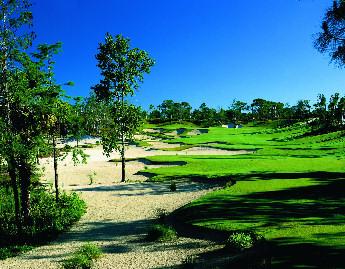Architects Vision
Featured courses by Hurdzan Fry Environmental Golf, by Design
Calusa Pines Golf Club
It takes a very special golf course to attract much attention in south Florida mainly because there are so many built with high budgets, big egos, and on relatively featureless sites. Calusa Pines distinguishes itself from its brethren because it goes to excess, some would say; but in such a subtle way that it becomes memorable. Named among the prestigious "Top Ten Best New Private Clubs" in the United States according to Golf Digest, Calusa Pines features outstanding vistas generated by sweeping ridges that influences ten golf holes. The landforms are so soft, and flowing that they blend in well enough to appear natural and unique. Combined with extensive native plant vegetation it is difficult to imagine the golf course was built, instead of simply laid out on this superb piece of land. Calusa Pines was founded to provide an exceptional golf experience for its members in a relaxed atmosphere that promotes camaraderie among those who truly love the game. The club doesn't release membership information, has no tee times, and features a strong caddie program as members and guests are encouraged to walk the course.
Golf Course Architect's Vision
FOR CALUSA PINES GOLF CLUB (C.P.G.C.)
By
Dr. Michael J. Hurdzan, ASGCA
Dana Fry, ASGCA
Looking at a golf course routing plan and understanding what kind of golf course it depicts takes study and vision…not to mention patience. To assist you in getting as excited as we are about the proposed golf course for Calusa Pines (C.P.), allow me to tell you what we see when we look at this plan.
First, realize that the drawing has only the two dimensions of length and width, but because of our experience we see a third dimension of height, which is the soul of a golf course. Additionally we know that this site is blessed with not only unique topography, but also a good diversity of vegetation to include open scrub, palmetto prairie, cypress hammocks, and pine-palmetto forest. Those various areas are shown on the drawing as different colors or textures.
Initially you will see the plan is dominated by green that defines the "preserve areas" isolated for environmental reasons, along with the blue water features that amount to over 37 acres, including the bass fishing lake. The golf course was designed to be fully integrated with these resources and to use them to give each hole a sense of privacy as well as a dramatic natural feature. As a result golfers will rarely see another golf hole other than the one they are playing, nor any building except the clubhouse, nor the large, yet exclusive practice facility, nor the entire surface of any water body. These are subtle but important design goals that distinguish a great course from a good one. Shown in brown are native sand scrub areas and palmetto prairies are showing in light green. Shown in greenish/gray are pined areas with cleared understory.
When we look at the plan we know that the clubhouse is located on top of a geologically unique fifteen-foot high sand ridge that will give commanding views of the 9th, 16th, and 18th green and the meandering lake that separates them. Although close by, you won't be able to see the unique double ended practice range with isolated tee areas, a multitude of target greens sized to demand 66% accuracy by USGA course rating standards and a unique short game area. You won't see service areas, dumpsters, employee parking, the maintenance facility and a whole lot of other things, to ensure that this club is a special place free of distractions. You won't hear traffic, or crowds, or airplanes, or sirens, or schools, or a lot of other things you don't need when you come to C.P. This is intended to be a tranquil place, full of fresh air and nature, within which to have memorable golf experiences with other discerning friends and members.
The setting is awesome but what about the golf course? How do you know it will be one of the finest in south Florida? Let me explain why we believe it will be worthy of Top 100 consideration. As you study the plan, notice that there is incredible variety in compass direction that each hole plays. Given a steady wind, nearly every hole will be affected differently, making the wind more than just an interesting factor, especially when it swirls in the trees. The first and only hole that even remotely plays into the rising sun is the 5th, and the only true west playing holes are the 3rd and 9th. The par 3's all play in different directions, as do the par 5's. Dogleg right holes tend to play easier for average players and more challenging for better players, hence there are more dogleg rights than left. All of this isn't by accident, it is by design. Calusa Pines will demand that you hit every club in your bag.
Many of the tee complexes are isolated as islands in a sea of native scrub, which is easy to play out of, yet reduces the environmental impact of golf on the land. In most instances the play angles from each tee are offset to increase the difficulty in shot value from the back and make the course more forgiving from the front tees. Native sand scrub areas will be complemented by a modest number of sand bunkers that have been thoughtfully placed to force strategic decision making. Greens will have well defined internal target areas ranging from easy to demanding, with putting surfaces of Tifeagle, which makes them putt comparably to bentgrass. All in all, the golf course will play with slope ratings as easy as perhaps 110 in the front and going up to mid 130's or higher from the back.
We could talk about the unique personality of each hole and why it is so different than any of its brethren, but we will save that until we get a chance to talk with you personally, or we spend some time on the course, either playing or during construction. Instead we would like to highlight a few of our favorite holes, and explain why the course will be so strong.
The third hole is a medium length par 3 that plays downhill across a unique palmetto prairie to a green complex set in a sea of native sand scrub. The second green and the tees on three were set into the clubhouse hill so a late arriving golfer could join up, that sudden death playoffs could start and end at the clubhouse, or a quick stop at the locker room or pro shop could be made, or a golfer could play holes numbers 1, 2, 3, 4, 5 and 2 for a quick, late afternoon six holes. That group of holes is as different to each other as could be, and hole number three will be one of the most fun to play for it will have a Pine Valley feel to it.
Another hole on the front nine that we believe everyone will enjoy is hole number eight. This is a drivable par 4, which means smart play gets an easy par or birdie, however daring play with a very long drive can yield an eagle. Daring play, however, might lead to a bogey or worse, for it requires a long drive over sand scrub and will require you to "stick it" on a medium to small sized green. But regardless of score it will be exciting to play.
Hole number nine is a demanding finish for the front nine requiring a powerful drive that must avoid the trees on the right and lake on the left in order to have a reasonable length second shot to a plateau green. The green will be cut into the clubhouse hill which means the second shot must carry all the way to the putting surface, in effect making the hole play one to two clubs longer. Local knowledge and skill play will be rewarded.
The eleventh hole on the map looks like a typical Florida par 3 hole played next to a lake. But what if the green were designed like the sixteenth at August National with a low back left shelf, a strong diagonal ridgeline running right to left within the green, a back tee at 215 yards, and a swirling wind caused by the bend in the lake. Now the hole goes from delightful to devilish depending upon the playing conditions for the day.
Three great finishing holes at Calusa Pines will provide a stern test to complete the round, but the toughest yet most exciting may be the 18th. To master this hole will require a strong drive to get past the left hand bunker and sentinel specimen tree on the inside of the dogleg. Not getting past these key elements virtually eliminates any chance of getting home in two, so now the golfer must choose whether to lay up in front of the cross bunkers in the second landing area, or trying to carry them. Either way leaves a wedge shot to a green situated 10 to 12 feet above the fairway. But if your drive is long and well positioned, getting home in two is an inviting possibility, except for a 12 to 15 foot deep bunker along the left front of the green. To have an eagle putt means carrying over that bunker and stopping the ball short of the back bunker. This closing sequence of holes may be the best in south Florida.
Calusa Pines will be a golfer's golf course meaning that you will never tire of playing it, there are an endless variety of golf shots required each time you play it, and every hole will be distinct and memorable. This is what Michael Hurdzan and Dana Fry see when we look at this routing plan.








